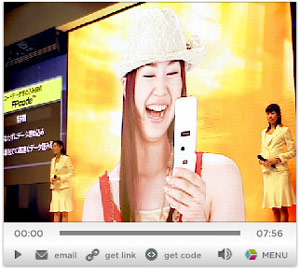 Last week, Tokyo’s annual CEATEC show (Combined Exhibition of Advanced Technologies) was once again a showcase for some of the coolest mobile technology on Planet Earth. Today’s video round-up features audio QR, Fujitsu’s ‘UB Wall‘ – an ultra-high-tech, one-to-one customized video advertising display – and FP codes, and – not to be missed – NTT DoCoMo’s 3G mobile-based ‘Drunk Driver’ detector, apparently in high demand by bus companies and trucking firms.
Last week, Tokyo’s annual CEATEC show (Combined Exhibition of Advanced Technologies) was once again a showcase for some of the coolest mobile technology on Planet Earth. Today’s video round-up features audio QR, Fujitsu’s ‘UB Wall‘ – an ultra-high-tech, one-to-one customized video advertising display – and FP codes, and – not to be missed – NTT DoCoMo’s 3G mobile-based ‘Drunk Driver’ detector, apparently in high demand by bus companies and trucking firms.
Organizers said that the consumer electronics event drew 550,732 during the public days, 4-7 October, while WWJ ducked in out of the torrential rain during the press & industry day on 3 October, when the crowds weren’t quite as waku (wild).
WWJ thinks the FP codes (essentially, invisible barcodes) and audio QR technology stands a pretty good chance of fast adoption, given the masses of rabid advertising agencies out there trying to capitalize on the growing popularity of (a) camera phones that grab info via QR code and (b) digital broadcasting. An audio QR code is simply broadcast as metadata in a digital audio signal, such that the browser displays text, a clickable URL or other advertising message while you listen to a radio or tv program on a suitably enabled mobile phone. But for sheer outdoor-advertising-meets-mobile marketing genius, the UB Wall can’t be beat!


 Last week, Tokyo’s annual
Last week, Tokyo’s annual